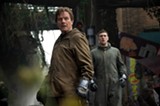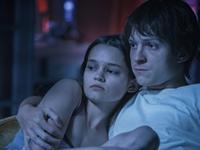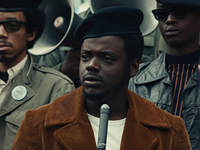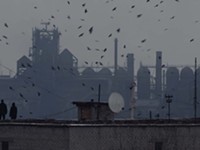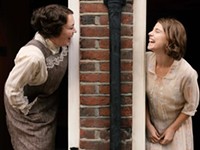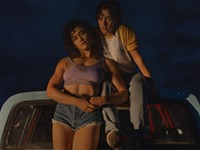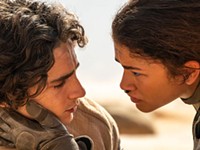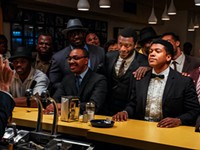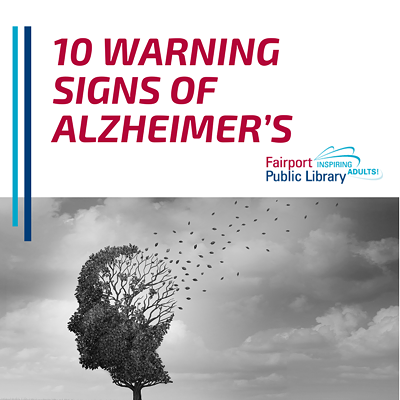[
{
"name": "500x250 Ad",
"insertPoint": "5",
"component": "15667920",
"parentWrapperClass": "",
"requiredCountToDisplay": "1"
}
]
The last time Godzilla lumbered his way into theaters in an American-originated film was back in 1998, when director Roland Emmerich attempted to capitalize on audiences' love affair with giant lizards — reawakened by the massive success of "Jurassic Park" and its sequel — by grafting them into another of his disaster porn epics, à la "Independence Day," with predictably abysmal results. That it's taken 16 years for someone to try again speaks to the amount of damage done to the big guy's brand by that film. Now British director Gareth Edwards takes a swing at the infamous kaiju, and his "Godzilla" benefits from his clear artistic vision.
Though Edwards — whose only previous experience was the micro-budgeted 2010 indie film, "Monsters" — is clearly also a fan of Steven Spielberg's creature features, he's an impeccable visual stylist with eye for spectacular imagery that captures the sense of wonder, awe, and terror of the King of the Monsters.
His film comes closer than any other Godzilla movie to capturing the somewhat mournful tone of the 1954 original, coming from Japan's grappling with a very real, and still very fresh fear of nuclear warfare, and Edwards is wise not to discount that aspect of Godzilla's legacy. The plot loosely centers around the Brody family, as they become caught up in the film's disastrous series of events. Bryan Cranston plays Joe, who works alongside his wife, Sandra (a criminally underused Juliette Binoche), as an engineer at a Japanese nuclear power plant. When the plant is destroyed early in the film by a series of earthquakes, Sandra perishes, leading Joe to become increasingly obsessed with the incident, convinced that the earthquake explanation provided by authorities is just a cover-up for what really happened.
The film jumps forward 15 years to find Joe and Sandra's son, Ford (Aaron Taylor-Johnson), now grown up, living in San Francisco, and working as a bomb disposal expert for the Navy. When he's called to collect his father in Japan after Joe runs afoul of the law for trespassing in the quarantined plant site, his arrival coincides with some familiar rumblings from beneath the Earth's surface. It turns out that Joe's conspiracy theories were not entirely unfounded, and we soon learn that the quakes are being caused by two MUTOs (Massive Unidentified Terrestrial Organisms) who've been awakened by humankind's meddling. And it turns out that they're not the only creature that's stirring.
Ken Watanabe and Sally Hawkins play scientists who've spent their lives studying these creatures and helpfully provide all the necessary exposition: it seems that the arrival of the MUTOs has triggered another creature to arise from beneath the ocean, whose job it is to restore nature's balance and safeguard the earth against these creatures, and his name is Godzilla. Unfortunately, it appears that the paths of all three creatures will converge in San Francisco, so something must be done to stop them
I've seen complaints about the size of Godzilla's role in the movie (he doesn't make his first full appearance until nearly an hour in), but people seem to have forgotten that he wasn't in large portions of the 1954 film either. While Edwards knows we're here to see giant monsters battle it out, he delays giving us what we want for quite some time, content to give us brief glimpses and cutting away just as the action seems to be getting good. Instead of following the template of most modern summer movies, which tend to feel like a long series of climaxes as action sequences pile up on one another, creating a numbing effect for audiences (see: "Man of Steel") the technique builds anticipation and the delayed gratification makes it all the more satisfying when we finally get to the carnage.
The problem comes in that all of the film's human characters are so thinly sketched that for all the time we spend with them, we never become invested in their stories. The film is loaded with great actors, but none of them is given a part to truly sink their teeth into, and the character we spend the most time with is played by the least compelling actor of the bunch. Aaron Taylor-Johnson isn't a strong enough presence to make his desperate attempts to reunite with his wife (played by a completely wasted Elizabeth Olsen) and young son compelling, but it doesn't help that the film falls into the trap of having him present at every crucial confrontation with the monsters, which starts to get a little ridiculous.
Still, in the end it doesn't really matter much. The film delivers where it's most important, making the monster-smashing action as spectacular as one could hope. Appropriately, Godzilla is given the full hero treatment in his battle scenes — just try to suppress a smile when he lets out his first mighty roar. In the end, the fact that the humans are constantly dwarfed by the behemoths around them is likely somewhat intentional. As they scramble to get out of the path of the massive, rampaging beasts, occasionally making ineffectual efforts to stop them, it's a reminder of how insignificant we are in the face of nature's power and sometimes all we can do is get out of the way.
